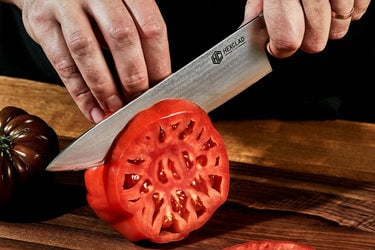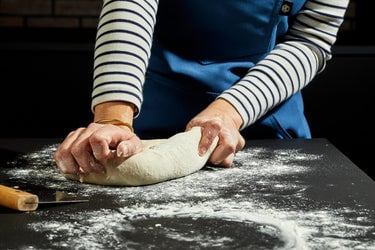Cooking Herbs: How To Cook With Herbs

Herbs can seem a bit more difficult to use than spices, but this doesn’t have to be the case — even if you’re still a beginner in the kitchen. In reality, cooking with herbs can be incredibly simple once you know the basics.
As long as you know how to pair tastes together, you’re most of the way there. If you’re ready to take your food to the next level with herbs, we have the details.
What Is the Difference Between Herbs and Spices?
An herb comes from a different part of the plant than a spice. Herbs are the lush, leafy part of the plant — think of sprigs of popular herbs, and chances are that they will feature either green leaves or a green stem.
A few popular herbs include:
- Chives
- Tarragon
- Fennel
- Anise
- Peppermint
- Spearmint
- Dill weed
- Parsley
- Marjoram
We’ll take the time to highlight a few other herbs later in this article, but this list is enough to get you started. Herbs can be either fresh or dried, whereas spices are almost always in a dry and powdered form. This is because they come from a dried part of the plant, such as the stem, flower, stalk, or seed.
Because of this, spices generally also have a much more condensed flavor. This means you want to use spices thoughtfully — they can pack a real punch, and adding too much of a good thing is a serious possibility.
That said, if you don’t use any spices, chances are you’ll end up with a final product that is largely flavorless and, well, boring… which is the lastthing anyone wants.
Herbs aren’t as outgoing with their flavor, so they sometimes have to be coaxed out with heat. Warm a fat like olive oil or butter in a high-quality pan, then add your desired amount of herbs.
Often, you’ll want to use both herbs and spices to create a well-rounded, full-bodied dish. Otherwise, you could end up with something one-note and forgettable. Taking the time to use both forms of flavoring pays major dividends and really doesn’t require much effort.
We highly recommend cooking this way whenever possible — you can create much more unique, striking taste combinations that ensure that every meal is one to remember.
How Should You Use Herbs in Cooking?
Now that we know more of what to expect from herbs, here’s how you can use them to enhance your food.
Choose Between Dried and Fresh
Making the decision between using dried or fresh herbs will rely on a few factors.
First, remember that some more obscure herbs might only be available in their dry form at your local supermarket.
Now, this doesn’t mean all is lost, and in certain situations, using dried herbs can even be preferable to using fresh ones.
Dried herbs tend to have a more concentrated flavor, so you won’t have to add as much to taste their effects. Some herbs, such as oregano, rosemary, sage, and bay leaves, still provide plenty of flavor and fun when dried. These herbs stand up well to being dried because they are fairly robust.
Conversely, more delicate herbs should always be used fresh, or else risk losing a great deal of their flavor. Parsley, cilantro, and fresh mint should be fresh whenever possible to ensure the strongest flavor.
Store Herbs Properly To Retain Flavor
When you get home from the store, it can be tempting to leave your fresh herbs as is and thoughtlessly toss them in the fridge — but this causes them to wilt and lose their flavor faster.
Regardless of whether your herbs are fragile or hearty, always start by washing and drying them thoroughly. Then, figure out what category of herb you have.
If the herb is delicate and green along its body, cut off the base of the stem, and place the herb in a jar with about an inch of water at the bottom. Put on a lid to cover the herbs, or place a plastic bag over the leaves as a makeshift cover. Hold it in place with a rubber band, and keep it in the fridge. If you don’t use the herbs right away, you might have to change the water every few days.
If you’re working with herbs with a woody stem resembling a tiny branch, put them side by side on a damp paper towel. Roll up your bundle of herbs and secure it with a sandwich bag or tightly-wrapped plastic bag.
If you want to preserve dried herbs, keep them in air-tight containers. When properly stored, dried herbs can last for one to four years.
A Little Often Goes a Long Way
Since the flavor and smell of herbs isn’t always as pronounced as it is with spices, you may naturally be compelled to add too much.
Keep in mind that an herb’s taste gets unlocked over time, so patience is key. You can always add more later, but removing the taste once you’ve added too much is a tough battle you are almost guaranteed to lose.
If you determine that you’ve added too many herbs, take them out of whatever you’re cooking. You can then water down their flavor by adding more of the other ingredients to the recipe.
That said, rather than ending up with significantly more of the dish than you intended, it’s much better to prevent this issue altogether and be mindful of how much you are adding.
The exact amount of herbs you need will depend on the herb's freshness. For example, dried herbs will have a different prevalence of flavor than something straight out of an herb garden.
If your recipe calls for a certain amount of herbs, follow it. As with all dishes, be sure to taste it as you go so you can make the perfect adjustments as needed.
Use Herbs To Add Flavor Depth
Herbs provide a level of flavor that is often impossible to reach with just seasoning alone.
By keeping your herbs well-preserved and using heat to bring out their natural taste and aroma, you can bring your cooking to new, impressive heights.
Add Your Herbs at the Right Part of the Cooking Process
Some herbs are best when given a bit of alone time to simmer for hours on end, while others are better when used as a last-minute, spontaneous addition.
To help illustrate this, let’s think about the difference between bay leaves and parsley. Bay leaves should be added to a soup or stew as soon as it’s on the stove. Parsley, however, is often sprinkled as a garnish to finish off a dish that is otherwise complete.
What Are Some Common Culinary Herbs?
Here’s a helpful overview of some of the most common herbs and when to use them.
Basil
This herb works wonders in all sorts of Italian foods. Fresh basil is one of the main ingredients in pesto, which gives it that characteristic green color you know and love.
It perfectly complements savory dishes by adding an element of freshness, but is versatile and can also add complexity to salad dressings like a vinaigrette.
Cilantro
You’re most likely to find cilantro in Mexican, Thai, Mediterranean, and Indian cuisines. It feels equally at home in an Indian curry as it does in a Thai stir-fry.
Cilantro also pairs well with coriander since they’re both different parts of the same plant.
Some unlucky people taste a soapy quality in cilantro because of a particular gene that can affect how the flavor is interpreted in the brain, but its prevalence (and rightful belonging) in Latin American and Southeast Asian cooking is undeniable.
Oregano
Oregano is another mainstay of Italian cuisine, but it’s also frequently used in Greek food. Oregano is delicious in tomato sauce, and it’s commonly dried and used in the “Italian seasoning” blend you’ll find at the grocery store.
Whether you use it fresh or dried, oregano’s earthy flavor pairs beautifully with higher-acidity sauces.
Bay Leaves
Most often, bay leaves are used in long-cooking foods like soups and stews. You should add them at the beginning of the cooking process to help them reach their full flavor potential by the time your dish reaches completion.
Bay leaves are used in many cuisines, like French, Spanish, Filipino, and Thai, just to name a few.
Parsley
Fresh parsley is often added at the end of the cooking process as an eye-catching garnish with a pop of color. There are a few different types of parsley that all have unique attributes.
A common debate among culinarians is Italian parsley (sometimes called “flat-leaf parsley”) versus curly parsley. However, chefs typically prefer flat-leaf parsley since it’s easier to work with and has a delightful peppery taste.
Rosemary
This herb is most often used to flavor red meat due to its rich, earthy quality. Pretty much any dish in need of a savory touch could benefit from a sprig or two of rosemary.
Sage
Sage is similar to rosemary in that it infuses earthiness into meats and root vegetables. Many of us associate the aroma and taste of sage with Thanksgiving foods, like stuffing, due to its prominence during the season.
Thyme
This herb is characterized by its rounded leaves and woody stem. It can help enhance the flavor of a variety of dishes by providing a fresh, light, almost citrusy taste.
How Do You Know If Your Herbs Are Fresh?
If your herbs are brown, shriveled, moldy, slimy, or wilted, you can rest assured they’ve gone bad and it’s time to toss ‘em.
When cared for correctly, fresh herbs usually last in the fridge for between one to three weeks. For the best flavor, plan to use them as soon as possible while they are still fresh.
The Bottom Line
When used correctly, herbs are a perfect way to elevate the flavor of your dish. From dill and chives to oregano and rosemary, there are many different herbs that can help you create complex flavors in your go-to recipes.
Feel free to experiment and find what tastes you prefer to master the art of cooking with herbs!
Sources:
Coriander (Cilantro) | Diseases and Pests, Description, Uses, Propagation | Plant Village
Tips on Cooking With Fresh Herbs | University of Maryland Extension
What Are Bay Leaves? | The Spruce Eats
A genetic variant near olfactory receptor genes influences cilantro preference | Flavour





